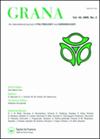Fossil Parkia R.Br. (Fabaceae) pollen from the Miocene of western Amazonia
IF 1
4区 生物学
Q4 PLANT SCIENCES
引用次数: 0
Abstract
Abstract The legume genus Parkia R.Br. has a pantropical distribution and centre of diversity in the Amazon. The molecular phylogeny of the group indicates a Neotropical origin in the Amazon biome during the Miocene, and habitat reconstruction points to terra firme (unflooded) forests. We examined recently described fossil pollen from the Miocene Solimões Formation in western Brazilian Amazonia attributed to this genus. Aiming to establish an infra-generic affinity, comparisons were performed between fossil pollen of Parkiidites marileae Leite and pollen from extant Parkia species using morphological characters and multivariate analyses. Parkiidites marileae is characterised by large and globose polyads, the polyads are composed of 16 monads, and the monads have a verrucate ornamentation. Analyses suggest two well-defined groups, a non-NLR (nearest living relative) group composed of P. decussata, P. gigantocarpa, P. velutina, P. panurensis, P. platycephala, P. pendula, P. multijuga, and P. ulei; and a NLR group composed of P. cachimboensis, P. discolor, P. igneiflora, P. lutea, and P. nitida. All species of the NLR group belong to the same clade, with a molecular age estimated at ∼12.8 million years, which is virtually the same age as interpreted for the first occurrence of P. marileae in the Solimões Formation. The late Middle to Late Miocene in western Amazonia was a time of gradual change from vast wetlands to more river-dominated landscapes that favoured unflooded forests where Parkia diversified and is distributed today.化石Parkia R.Br。(豆科)来自亚马逊西部中新世的花粉
豆科植物Parkia R.Br。在亚马逊河流域有泛热带分布和多样性中心。该物种的分子系统发育表明其起源于中新世亚马逊生物群系的新热带地区,而栖息地重建则指向陆地(未被淹没的)森林。我们研究了最近描述的巴西西部亚马逊地区中新世Solimões组的花粉化石,归于该属。为了建立其近属亲缘关系,利用形态学特征和多变量分析对marileae Leite Parkiidites化石花粉与现存Parkiidites花粉进行了比较。marileeparkiidides marileae的特点是大而球状的多聚体,多聚体由16个单聚体组成,单聚体有疣状纹饰。分析表明有两个明确的类群,一个非nlr(最近的近亲)类群,由P. decussata、P. gigantocarpa、P. velutina、P. panurensis、P. platycephala、P. pendula、P. multijuga和P. ulei组成;NLR类群由P. cachimboensis、P. discolor、P. igneiflora、P. lutea和P. nitida组成。NLR群的所有物种都属于同一个进化支,其分子年龄估计为~ 1280万年,这与P. marileae在Solimões组首次出现的年龄几乎相同。在亚马逊西部的中新世晚期到中新世晚期,是一个逐渐从广阔的湿地转变为更多以河流为主导的景观的时期,这种景观有利于未被淹没的森林,帕克亚在那里多样化并分布于今天。
本文章由计算机程序翻译,如有差异,请以英文原文为准。
求助全文
约1分钟内获得全文
求助全文
来源期刊

Grana
生物-植物科学
CiteScore
2.10
自引率
11.10%
发文量
23
审稿时长
>12 weeks
期刊介绍:
Grana is an international journal of palynology and aerobiology. It is published under the auspices of the Scandinavian Palynological Collegium (CPS) in affiliation with the International Association for Aerobiology (IAA). Grana publishes original papers, mainly on ontogony (morphology, and ultrastructure of pollen grains and spores of Eucaryota and their importance for plant taxonomy, ecology, phytogeography, paleobotany, etc.) and aerobiology. All submitted manuscripts are subject to initial appraisal by the Editors, and, if found suitable for further consideration, to peer review by independent, anonymous expert referees. All peer review is single blind and submission is online via ScholarOne Manuscripts.
 求助内容:
求助内容: 应助结果提醒方式:
应助结果提醒方式:


